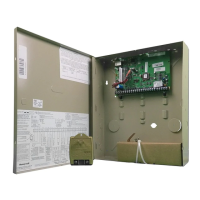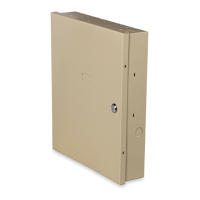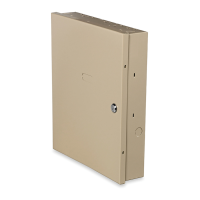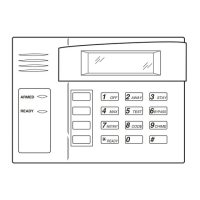NIC IP Address [255.255.255.255]
Enter the 4-part IP address for this device, separating each part with a space
([∗] key, displayed as periods). [#] to continue
Subnet Mask [255.255.255.255]
Enter the 32-bit address mask used to indicate the portion (bits) of the IP
address that is being used for the subnet address, separating each part with a
space ([∗] key, displayed as periods). [#] to continue
Gateway IP Addr [255.255.255.255]
Enter the 4-part IP address assigned to the Gateway, separating each part with
a space ([∗] key, displayed as periods). If unused set to 0.0.0.0.
[#] to continue
DNS IP Addr [255.255.255.255]
Enter the 4-part IP address assigned to the DNS (Domain Name System)
server, separating each part with a space ([∗] key, displayed as periods). If
unused set to 0.0.0.0. [#] to continue
Review? (and Exit ∗
∗∗
∗29 Menu mode or Reset Defaults)
You can review the ∗29 Menu mode options to ensure that the correct entries
have been made. When satisfied, select [N] to exit ∗29 Menu mode.
To review prompts or exit ∗
∗∗
∗29 Menu mode:
[Y] = review prompts and entries, starting with Internal Device. Use the
up/down arrow keys to scroll through the program fields without changing
any of the values. If a value requires change, simply type in the correct
value. When the last field is displayed, the “REVIEW?” prompt appears.
[N] = Exit *29 menu mode and return to data field programming mode. The
prompt briefly displays “DONE” before returning to data field mode
prompt “Enter ∗ or #.”
[#] to accept Y or N selection (# alone exits same as N)
To reset ∗
∗∗
∗29 Menu mode defaults:
Press [ESC] at the Review prompt to display the “Set Defaults” prompt.
[Y] = reset ∗29 menu mode options to factory values; if selected, all
programmed ∗29 Menu mode options are reset to the factory settings
[N] = cancel reset defaults function
Programming IP/GSM Options via AlarmNet Direct Website
To program the IP/GSM options via the AlarmNet Direct website (if you are
already signed up for this service), go to:
https://services.alarmnet.com/AlarmNetDirect/userlogin.aspx
If you are not signed up for this service, click on “Dealer Sign-Up.
Log in and follow the on-screen prompts.
Please have the following information available:
1. Primary City ID (two-digit number)
2. Primary Central Station ID (two-digit hexadecimal number)
3. Primary Subscriber ID (four-digit number)
4. MAC ID and MAC CRC number (located on the outside of box and on label
inside module) or MIN number of the device you are replacing
5. Mode of operation of existing module if replacing a "C" series radio.
After programming is complete, you must transfer the data to the module and the
module must be registered. Refer to the Registration section for details.
IP/GSM Diagnostic Commands (∗
∗∗
∗29 Menu Mode)
Diagnostic commands can be used to quickly view your Internet and GSM
connectivity settings and options. For each command press the [shift] key and
then the designated command key. For example, press [shift] then [1/A] to
display the software revision screen.
To enter Diagnostic mode:
1. Press ∗29 while in data field programming mode.
2. Enter “1” at the “Enable IP/GSM” prompt then press [∗].
3. Select “2” (Diag) at the next prompt.
4. Enter the desired command at the “Sel Key Command” prompt.
For subsequent commands, enter the next command at the current screen.
To exit Diagnostic mode, press ESC (shift-[A]).
Key Prompt Function
[A]
Internal IP/GSM
x.x.xx mm/dd/yy
Software Revision
"x.x.xx" indicates the installed
software Revision. Mm/dd/yy
indicates month, day and year of
the revision.
[B]
MAC xxxxxxxxxxxx
MAC CRC yyyy
MAC Address
“xxxxxxxxxxxx” indicates the
IP/GSM’s unique identification
number. Yyyy indicates the 4
digit MAC CRC needed to enroll
the device in dealer direct.
[∗] to continue to SCID.
SCID xxxxx xxxxx
xxxxx xxxxx
SCID Display
Only if GSM or IP/GSM enabled.
Displays the identification
number assigned to the SIM
card (SCID) in this device.
[∗] to continue to IMEI.
IMEI xxxxxxxx
Xxxxxx x
IMEI Display
Only if GSM or IP/GSM enabled.
Displays the identification
number assigned to the GSM
module in this device.
[∗] returns to MAC Address.
IP/GSM Diagnostic Commands (continued)
Key Prompt Function
[C]
Mon 01 Jan 2006
05:48:39 am
Time
Retrieves the current date and
time from the AlarmNet network
in Greenwich Mean Time (GMT).
This display confirms that the
module is in sync with network.
[D]
Physical Link
Good/Bad
Physical Link
Only if IP or IP/GSM enabled.
Indicates whether the device has
detected a physical connection
to the internet.
[∗] to continue to NIC IP address.
NIC IP Address
xxx.xxx.xxx.xxx
IP Information Displays
Displays the IP address
assigned to this device.
[∗] to continue to subnet mask.
Subnet Mask
xxx.xxx.xxx.xxx
Displays the 32-bit address mask
used to indicate the portion (bits)
of the IP Address that is being
used for the subnet address.
[∗] to continue to gateway IP.
Gateway IP Addr
xxx.xxx.xxx.xxx
Displays the IP Address
assigned to the Gateway.
[∗] to continue to DNS server IP.
DNS Serv IP
xxx.xxx.xxx.xxx
Displays the IP Address
assigned to the DNS (Domain
Name System) server.
[∗] to continue to encryption test.
Encryption Test
AES
Passed!
Performs a self-test of the AES
encryption algorithm.
[∗] to continue to DHCP.
DHCP
OK
DHCP (Dynamic Host
Configuration Protocol)
indicates server is performing
satisfactorily.
[∗] returns to Physical Link prompt.
[E]
PriRSSI GPRS REG
-xxxdbm x x
GSM Status Displays
Only if GSM or IP/GSM enabled.
PriRSSI – Primary Site RSSI
level in dbm
GPRS – GPRS Service
availability where “x” can be:
“Y” if GPRS is available
“N” if GPRS is Not available
REG – Registration status
from GSM module where
“x” can be:
N – Not Registered
H – Registered Home
S – Searching
D – Registration Denied
R – Registered Roaming
? – Unknown Reg. State
[∗] to continue to next screen.
Cntry Netw LAC
xxx xxx xxxxx
Cntry – Country Code
Netw – Network Code
LAC – Reg. status from GSM.
[∗] to continue to next screen.
Cell BaseSt Chan
Xxxxx x xxx
Cell – Base Station ID
BaseSt – Base Station Antenna
Sector
Chan – Control Channel in use
[∗] to continue to next screen.
Second Site RSSI
-xxxdbm
Secondary GSM Site RSSI level
in dbm.
[∗] to continue to next screen.
[F]
Testing Gateway
Redir 1
Network Diagnostic Test
Only if IP or IP/GSM enabled.
Performs a set of network
diagnostics that tests the
integrity of the links between the
IP/GSM and the various
connection points (Redirs) to
AlarmNet.
[S]
ECP FLT
OK
Status request
OK = normal
i = IP off line
I = IP fault reported
g = GSM off line
G = GSM fault reported
– 14 –
WWW.DIYALARMFORUM.COM
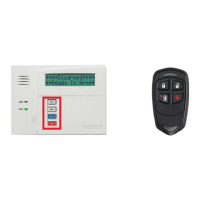
